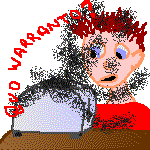 |
|
|
Dating
Manuscripts |
|
|
We
are very particular about dating our written productions today. Books
will have a date of publication entered, along with a list of the dates
of all previous editions if we have been so lucky. Magazines and newspapers
have dates. Dates are essential to all legal and business documents, otherwise
the toaster would not know when the warranty had expired so it could burn
out. |
|
|
 |
The
dating of manuscript
material from the medieval era can be a bit more tricky. As far as books
are concerned, because of the long chains of transcription
through the ages, the date of authorship of a work and the date of production
of any particular copy have no particular relationship, except that the
former must come first. Material from Classical Rome was transcribed for
a thousand years and more. Finding the oldest extant version of a work
can be a complex detective enterprise. |
|
|
Illustration
from a 12th century copy of the Classical comedies of Terence (Bodleian
Library, Auct. F.2.13, f.105). |
|
|
Sometimes
a date may be entered in a scribe’s
colophon, indicating
the date of transcription of a manuscript |
|
|
Catalogue
descriptions of monastic libraries may be consulted in order to discover
when a work was entered and what information was entered about it. Some
such catalogues exist from the middle ages, in manuscript form. Others
were compiled by the antiquarians who first picked over the wreckage of
the monastic libraries after they were dissolved or dispersed. Identifying
particular manuscripts with ones that have been described may be aided
if they contain inscriptions which give the names of owners at particular
times. |
|
 |
Introduction
to a 15th century catalogue of the Premonstatensian monastery of Titchfield.
This section describes the layout of the library and the letters on the
shelves. From the library of the Duke of Portland. |
|
| Scholars
from a more leisurely age who obviously didn’t have dinners to cook or
horses to feed have compiled a vast amount of factual data on such matters,
which resides in dusty old journals that your university library may be
tempted to dispose of in order to replace them with trendy modern discourses.
Do not let them do it. These resources can never be replaced. |
|
|
Manuscripts
can be dated, to a certain level of accuracy, by examining their scripts.
I was once fortunate enough to attend a paleography school run by Christopher de Hamel in which we were taught to play “The
Paleography Game”, which more or less involves betting on your own degree
of accuracy at dating scripts. It was invented in the hallowed halls of
academe, or more likely the hallowed pubs, and is no doubt infinitely
amusing if accompanied by schooners of port as forfeits. The point of
the game is actually that the degree of accuracy of dating scripts is
a bit wobbly, even when comparing with known examples. |
|
|
Changes
in calligraphic fashion did not happen cataclysmically. There were trendy modern scribes
and stuffy old fashioned scribes at any point in time, and there were
scribes who could write modern or traditional, depending on how you wanted
it. Nevertheless, there are general patterns that can be used to date
handwriting, provided you are not too ambitious. |
|
|
For
illuminated
manuscripts, stylistic analysis of the decoration also helps to provide
a date. This is a huge area of study, but there are some things that jump
out at even the observant amateur, although the question of why certain
fashions come and go is more complicated. |
|
|
For
example, why do the hems of garments on late Anglo-Saxon illustrations
go into such frilly curves? |
|
 |
|
|
Figure
from a calendar illustration for January in the early 11th century Julius
Calendar (British Library, Cotton Julius A VI, f.3a). By permission of
the British Library. |
|
 |
Why
in the 12th century did they like to do initials in a motif that looks
like a lion eating spinach? |
|
| Lion
initial from a late 12th century version of Gaius Suetonius Tranquillus "De Vita Caesarum" (British Library, Egerton 3055, f.2). By
permission of the British Library. |
|
 |
Why
are the borders of 14th century manuscripts of great significance and
solemnity adorned with mad monkeys, birds with their heads in pots and
strange creatures that look as if they were invented by a medieval Dr
Seuss? |
|
 |
A
monkey drives a cart and a creature with strange furry feet plays a fiddle
in the borders of pages of the 14th century Luttrell Psalter, now in the
British Library. |
|
 |
Why,
in the 15th century, did they go so crazy on flowers? |
|
|
|
|
|
|
|
|
|
Flower
motifs in the border of an abstract of agreement between Henry VII and
the abbot and convent of Westminster (British Library, Harley 1498, f.76).
By permission of the British Library. |
|
|
There
are technical terms for all these things, and hundreds more beside, but
anyone can look and create their own mental visual encyclopedia. |
|
|
continued |
|
 Why
Read It? Why
Read It? |
|
|
|
|
|
|
|
|
|
|
|
|







